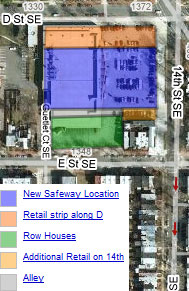Pimp my Safeway: Redevelopment potential for the Capitol Hill Safeway
This past spring, Georgetown’s “Social Safeway” closed so that it can be torn down and rebuilt. The new Safeway will be a two-story building with street-facing stores along the sidewalk, the grocery store on the second floor, and parking behind. Farther up Wisconsin, a Giant supermarket is also pursuing a new urban design that will “replace bland, single-story buildings and large surface parking lots along Wisconsin Ave and Idaho Ave with an appropriately scaled mixed-use project that will engage the street with many individual stores and residences.” These are good plans and we need to urbanize more suburban-style grocery stores in the District. The next such site should be the “UnSafeway” at 415 14th St, SE.
This Capitol Hill Safeway’s site has a colorful history. In the late 19th century it was the site of a brewery that in 1891 became Albert Carry’s National Capital Brewery.
The main brewing building was 135 ft. tall, not including the flag towers, 94 feet wide and 137 ft. deep. A substantial stables and a huge icehouse operation flanked the building. On opening the brewery had nine large wagons pulled by 30 “Percheron” horses. The ice house was powered by two, 80 horsepower, steam engines and could produce 50 tons of ice running at maximum. The brewery’s output capacity was a staggering 100,000 barrels annually. Since a barrel contained about 30 gallons, the brewery produced and sold more than 24 million pints of beer in its heyday.”
It operated for more than 20 years (serving as the site of a notorious murder mystery in 1912). After Prohibition, like many other breweries, it was converted to an ice cream factory — the Carry Ice Cream Company. It was a complete success. Meadow Gold bought the company in 1918, becoming one of the first companies to sell the Dixie Cup.
At some point (various sources disagree) it became a Sanitary Grocery, and later became a Safeway. The Brewery was knocked down, and a one level grocery store opened its place. The grocery’s entrance is set far back behind a parking lot, and a long blank wall faces D Street.
But the Safeway Company has an opportunity to capitalize on this underdeveloped site. They could move the grocery store entrance to the sidewalk along 14th Street, and turn the store 90 degrees so the narrower edge faces 14th. The store would back onto Guellet Court, across the street from a parking lot.
This would free up space along D and 13th 14th for retail, including the retail already inside the store. Currently, in addition to a grocery store, the Safeway houses a pharmacy, a Starbucks, a liquor store and a bank. All of these could moved outside the store and onto D Street, wrapping around the corner onto 13th 14th along with other neighborhood appropriate retail. Starbucks, or other such retail, could spill out onto the wide sidewalks.
Below the grocery store could be a parking garage, accessible from Guellet Court, and large enough to meet the needs of residents and shoppers, with Zipcar and bike parking of course. The site is close to the Potomac Avenue Metro and major bus lines, and located in a walkable and bikeable neighborhood. Therefore, many shoppers won’t need to drive to the store.
Two to four floors of housing could sit atop the store. The historic row houses along E Street in the southeast corner of the block, could form the end of a new, longer row stretching to just east of Guellet Court, leaving space for a loading dock.
Safeway would stand to make a fortune. In addition to monetizing the largest commercial parking lot on the Hill, Safeway would add to its customer base. Perhaps the new development would even include a Capital City Brewery Company and a small ice cream shop — for old time’s sake.




